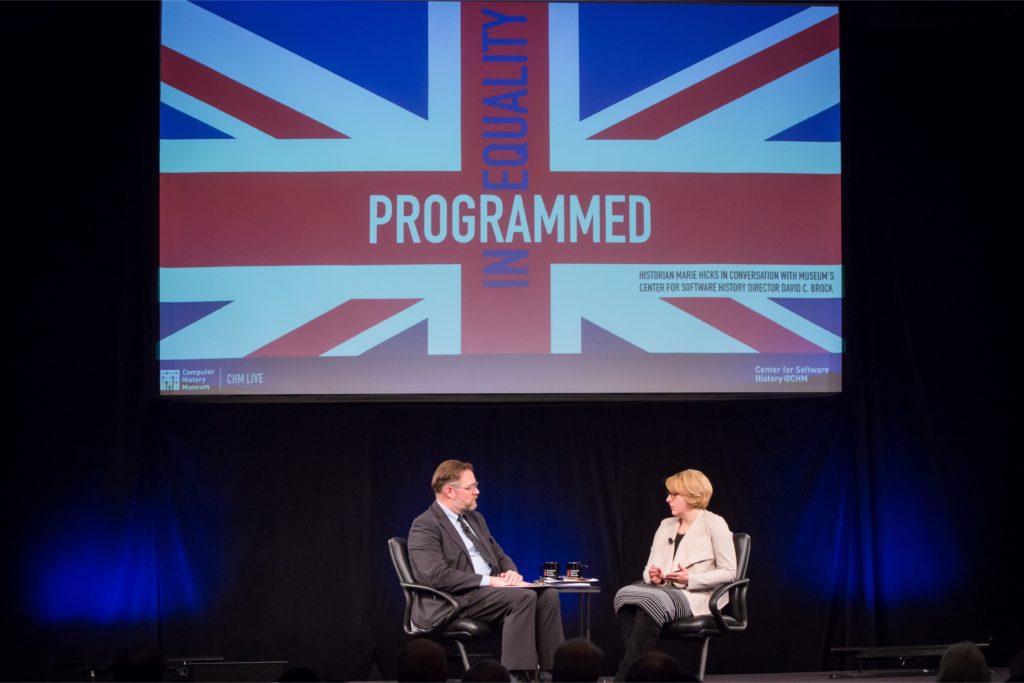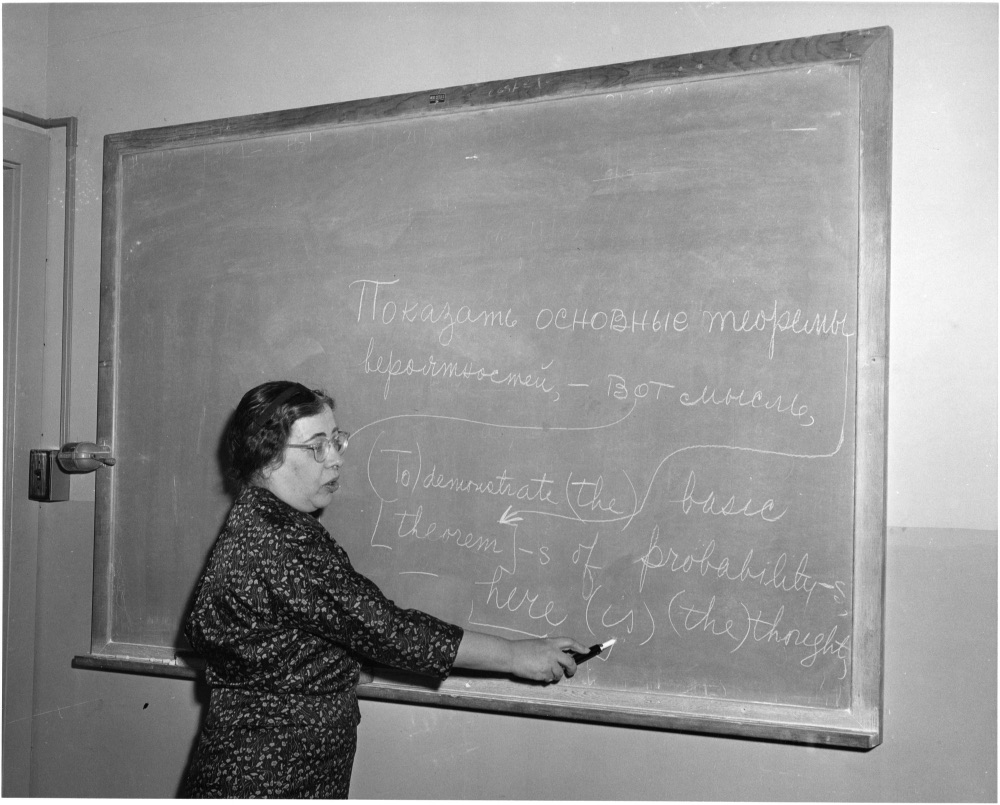

“Programmed Inequality: Dr. Marie Hicks in Conversation with the Museum’s Center for Software History Director David C. Brock,” December 6, 2017. Produced by the Center for Software History at the Computer History Museum.
The experience of women, and the issues of gender and sexuality, are vitally important to our understanding of the story of computing, and hence our contemporary world, for many reasons. Perhaps most straightforwardly, women have been ubiquitous throughout the history of computing as makers and users of it. As Eileen Clancy, the archivist and City University of New York graduate student, so aptly put it in her recent talk “Sekiko Yoshida: Abacus ‘Software’ in the Early US Space Program” at the Society for the History of Technology’s 2017 meeting: “The women are always there, if you look for them.”
In contrast to their essential roles, women have far too often been rendered invisible, absent from historical accounts and understandings. Sometimes, this invisibility is a deliberate erasure in which the contributions of women to computing work of various sorts was devalued culturally and economically, and thus went without recognition or documentation. Indeed, as the historian of computing Marie Hicks recently noted at a fascinating CHM Live event at the Computer History Museum about her new book Programmed Inequality: How Britain Discarded Women Technologists and Lost its Edge in Computing, it was the very fact that women did particular kinds of work in computing that this work was devalued, and unrecorded.
Hicks’ carefully researched and thoughtful study treats the experience of women, and the centrality of gender and sexuality, in the history of computing in Britain in the crucial decades of the 1940s to the 1970s. Our full discussion of her book may be viewed below.
In brief, Hicks’ study traces how women were essential to the emergence of electronic computing, and to the growing use of electromechanical computing machinery like tabulators, in the 1940s through their efforts in the British code-breaking efforts centered on the now-legendary Bletchley Park. Britain struggled to rebuild itself and its economy in the immediate postwar, centered on state actions like the growth of its Civil Service to become the nation’s largest employer, the creation of the National Health Service, and the nationalization of several industries.
In the transition from a war footing to peacetime, many of the pioneering women in computing were pushed out through overt discrimination, and, as Hicks insightfully documents, a system of employment and compensation based on a presumed or enforced heterosexuality, in which women were assumed to be destined for marriage and, with it, motherhood. This presumed heteronormativity of future husbands and children grounded a system in which women were employed in computing in ways that were explicitly temporary, without paths for sustained career development. Indeed, Hicks details the ways in which the Civil Service contorted itself to prevent any woman from supervising a man, even when women had depth of knowledge and experience that completely eclipsed men coming into computing work. Managers valued these forms of discrimination in British computing, particularly in state-governed workplaces. They allowed women to be employed as the operators of computing machinery at steady, low wages, while they dramatically increased their number in Britain’s push to computerize. If men, who demanded career paths and higher wages, had done the work, the direct costs of computerization would have been tremendously larger.
However, Hicks details, this attention to direct savings overlooked the broader costs of excluding women from particular roles in computing, from restricting their work in computing to “operators,” as crucial (and crucially flexible) as this work was, and from the waste of experience due to the temp-worker glass ceiling to which women were consigned under the banner of presumed traditional marriage. These costs and losses, Hicks argues, led to chronic shortages of labor and expertise in computing that Britain, facing grave economic and social challenges in the first decades of electronic computing, could ill-afford. If not the single cause of the decline of the British computing industry, this loss and waste from the restriction of women’s contributions was a contributing factor. There are many other dimensions to Hicks’ Programmed Inequality beyond the scope of this essay, and readers are strongly encouraged to watch our CHM Live event recording and to explore the book themselves.
As an historian and curator at the Computer History Museum, my interview with Professor Hicks, and my reading of her Programmed Inequality, led me to see a way in which the system of presumed heterosexuality that she discusses for excluding women from certain kinds of participation in computing might also be a factor in the underrepresentation of women in archival collections connected to computer history. How do personal and professional papers find their way into archives? In some cases, it is through proactive planning and work with the individual themselves. The archive, or its surrounding institution, may have an existing relationship with the individual, with both convinced in the historical value of the collection and the suitability of the archive for long-term preservation. However, my intuition and experience lead me to the opinion that this is not the predominant case. Plans for the eventual disposition of one’s papers is one of those end-of-life issues and decisions that we choose to think are at some great remove, and move to the bottom of the to-do list.
Just as often, it seems the papers of important contributors to the story of computing come into archives through the dedicated work of the contributor’s spouse or children at the end of the contributor’s life or after their death. Until recently, the possibility to have a spouse and children was nearly entirely limited to heterosexuals, or to those who at least performed as such. What this means is that contributors to the history of computing who did not fit the mold of traditional heteronormativity were more at risk for having their personal and professional papers lost to the archive, lacking the spouses or children to whom the task of preservation so frequently falls.
One of the most personally frustrating examples of this archival absence from heteronormative noncompliance is the case of Ida Rhodes, born Hadassah Itzkowitz, who lived from 1900 to 1986. Rhodes was a remarkable character. She came with her parents from Ukraine to New York’s Lower East Side in 1913. She earned a BA and MA in mathematics from Cornell University by 1923, and, in 1940 joined the famed Mathematical Tables Project in New York City in 1940. There she both worked as a “computer” for calculating these volumes of mathematical values and orchestrated the work of other computers on the project. Through the project’s connection to the National Bureau of Standards, Rhodes was drawn into electronic computing in its earliest years. In 1947, she joined the electronic computing effort of the National Bureau of Standards in Washington, DC, where she would go on to become a critical software figure in many early applications of computing by the US federal government, including the Census and Social Security Administration. During her long career at the bureau before her 1964 retirement, Rhodes also was an early pioneer of the use of electronic computing for automated translation, in particular English-Russian translation. Moreover, Rhodes was a renowned correspondent on technical and other topics with a wide international circle, including Albert Einstein. Much of what we know about her and her career is due to the painstaking efforts of historian David Allen Grier.

Ida Rhodes (1900-1986) was a mathematician at US National Bureau of Standards, an expert on electronic data processing, and a pioneer in the development of modern computers. Photo credit: Acc. 90-105 – Science Service, Records, 1920s-1970s, Smithsonian Institution Archives
The challenges of aging saw Ida Rhodes eventually enter a nursing home, where she died in 1986. Divorced, and without children, she did not have the additional support that so many rely on for the archival preservation of their personal and professional papers. Despite efforts to find what must have been a remarkable collection on early computing, software, the history of mathematics, and cultural history, Ida Rhodes’ collection appears entirely lost to history. Perhaps there is a lesson here for archivists and curators to create better systems of outreach and collection for those who do not have others to assist in their affairs.
While much of Ida Rhodes’ experience and voice is lost to history, it is not all. In 1952, she published a remarkable short essay in a then and now rare conference proceedings by the Institute of Radio Engineers (one of the successors to today’s IEEE), “The Human Computer’s Dreams of the Future.” In it, she lays out a vision for what she thought computing might become by 1972. It is fascinating to see what this computer turned computing pioneer imagined might be computing’s future. In keeping with the concern with the visibility and recognition of women in the history of computing in Marie Hicks’ Programmed Inequality, the Computer History Museum is happy to make this essay openly available on the web for the first time, with the permission of the IEEE.
The CHM Live team caught up with Dr. Marie Hicks backstage to chat firsts and favorites. Here’s what she shared.
CHM Live: Who are you following on social media?
Marie Hicks: Everyone interested in the history and social studies of technology should definitely follow @ubiquity75 @safiyanoble @ladyxscience @bhgross144 @logicmagazine @IBJIYONGI @alondra @miriamkp @ThenJenniSaid @akbarjenkins @sigcis @orbitaldecay and @luke_stark. Other great accounts I’m following right now from the worlds of media and history include @loganjaffe @CriminalShow @mckellogs and @rayshaunagray.
CHM Live: What’s the best part of your job?
Hicks: It’s the part when I have a eureka moment in my research or writing, and I get to share that with other people—either the public or my students—who then get equally excited about that new bit of knowledge or new insight.
CHM Live: What’s your favorite piece advice?
Hicks: A fortune cookie once told me “you can’t cross a chasm in two small jumps.” It’s true, but I think so often we forget the importance of taking big, bold steps—we try to talk ourselves into what we perceive as safer options. I think this is especially true for folks who come from backgrounds of a less privileged nature, where one failure can be enough to derail your education or your career.
CHM Live: What was your first computer?
Hicks: An Apple IIe with no peripherals other than a green and black monitor and a floppy drive. I tried so hard to play games on it, but it was pretty boring. My mom used it for FORTRAN programming and some other stuff. I hated it and envied my friends who had Commodores or even TRS-80s.
CHM Live: What’s on your must-watch Netflix/HBO/Hulu/Network TV series list?
Hicks: I’m a really big fan of documentaries so for me, some must-watch streaming films on the major content providers right now are Wormwood, Kiki, The Pruitt Igoe Myth, Citizen Jane: Battle for the City, and Unbought and Unbossed: The Shirley Chisholm Story. They’re all great documentaries that will captivate you and teach you a lot about American history in under an hour and a half each.
CHM Live: Which current moonshot/tech project would you most like to happen?
Hicks: I’d like to see Safiya Noble’s and Sarah Roberts’ alternative search engine, which is not ad-driven and is fully transparent about its potential biases, kick Google out of its top place in curating information (read more about their project here), and I’d like to see @AdrianCJax’s Exodus project end Twitter and Facebook’s racist, sexist, and quite likely treasonous stranglehold over the USA. I hope 2018 is the year when grassroots resistance against online monopolies really gains traction.